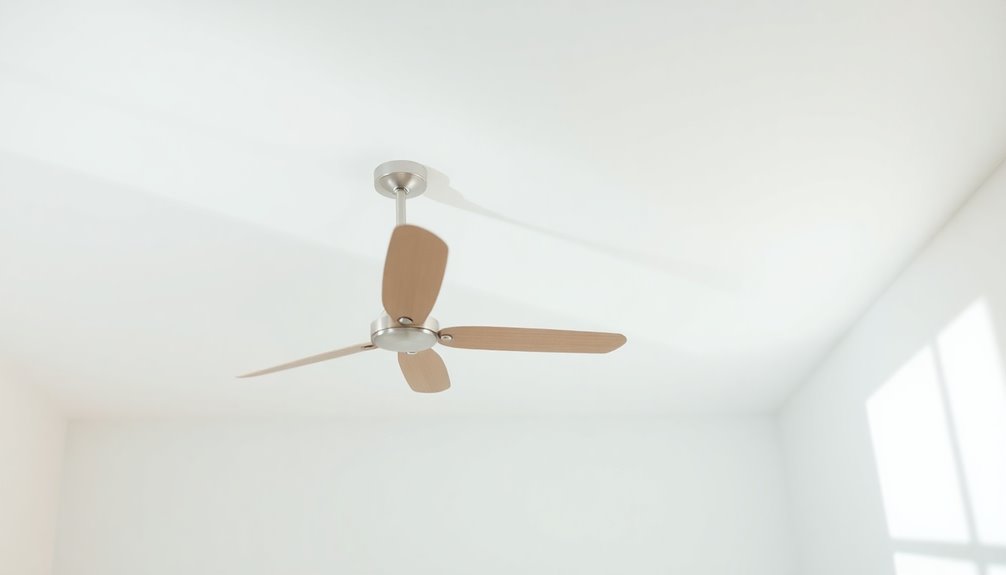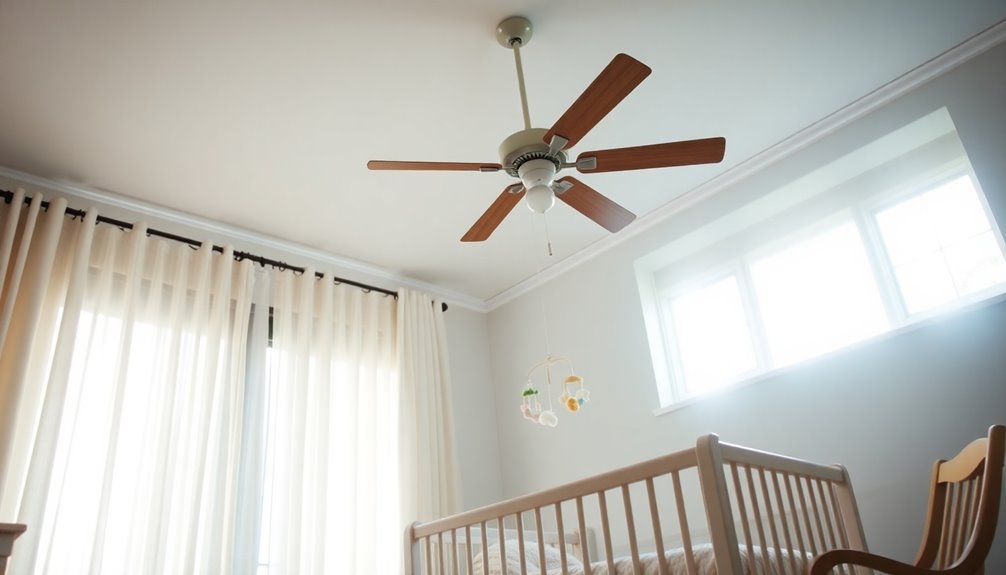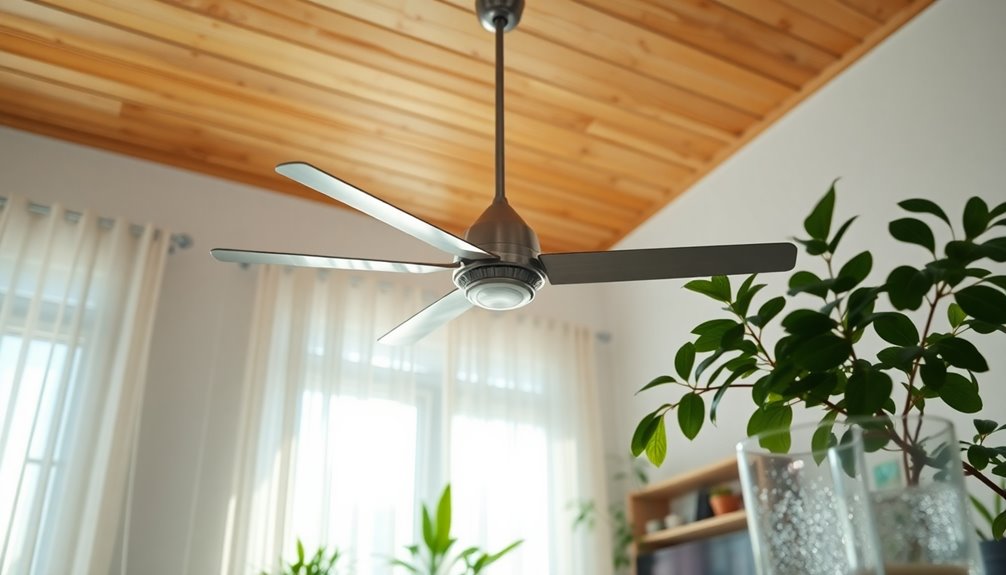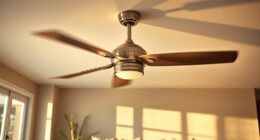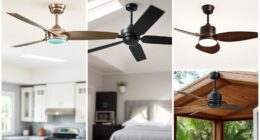A low profile ceiling fan, often called a hugger or flush mount fan, is perfect for rooms with low ceilings. These fans are specially designed to sit snug against the ceiling, typically for spaces with ceilings under eight feet high. They provide effective air circulation while maximizing headroom, ensuring you don't hit your head. With various styles and energy-efficient options, they enhance comfort and lower your energy costs. Plus, their quiet operation keeps your space peaceful. If you're curious about their features and how to choose the right one, there's plenty more to discover.
Key Takeaways
- Low profile ceiling fans, also known as hugger or flush mount fans, are designed for ceilings under 8 feet in height.
- They maintain a minimum blade height of 7 inches from the floor, optimizing headroom in low-ceiling spaces.
- These fans enhance air circulation and comfort while being energy-efficient, reducing electricity costs significantly.
- Available in various styles and customizable options, they cater to diverse aesthetic preferences.
- Low profile fans are installed close to the ceiling, ensuring safety and minimizing contact risks in compact spaces.
Definition of Low Profile Ceiling Fans

Low-profile ceiling fans, often referred to as hugger or flush mount fans, are designed to sit snugly against the ceiling, making them perfect for rooms with low ceilings.
These fans are specifically tailored for spaces where the ceiling height is under 8 feet, ensuring you get the airflow you need without sacrificing safety or comfort. With a minimum blade height of just 7 inches from the floor, low-profile ceiling fans optimize air circulation while providing maximum headroom.
Flush mount ceiling fans operate similarly to traditional ceiling fans but are engineered to minimize the risk of contact with occupants. They maintain a required distance of at least 30 inches between the blade tips and the nearest wall or obstruction, which helps comply with safety regulations.
This design allows you to enjoy effective airflow in tight spaces, elevating the comfort in your living areas without overwhelming the room's aesthetic.
Choosing low-profile ceiling fans means you can enhance air circulation in your home while keeping the look sleek and unobtrusive.
Whether you're updating a cozy bedroom or a small living room, these fans are the ideal solution for maximizing comfort in rooms with low ceilings.
Benefits of Low Profile Ceiling Fans

Low profile ceiling fans are perfect for optimizing space in rooms with lower ceilings, ensuring you don't sacrifice headroom.
Not only do they save you money on energy costs by using less electricity, but they also enhance air circulation, keeping your space cool and comfortable.
With their sleek design, these fans fit seamlessly into any decor while delivering practical benefits. Additionally, they often feature energy-efficient motors that contribute to reduced electricity bills.
Space Optimization in Rooms
When you're dealing with a room that has low ceilings, optimizing the space can be a challenge. Low-profile ceiling fans are designed specifically for small rooms with low ceilings, making them a perfect solution for enhancing your space.
Here's how they can help:
- Save Vertical Space: Flush-mount ceiling fans sit closer to the ceiling, allowing you to maximize height and avoid any obstruction.
- Improve Air Circulation: These fans efficiently circulate air, keeping your room comfortable without the bulk of air conditioning.
- Versatile Lighting Options: Many low-profile fans come with built-in lighting, providing illumination while saving space.
- Stylish Designs: Available in various styles, low-profile ceiling fans can elevate the aesthetic value of your room and complement your decor.
Energy Cost Savings
Investing in a low-profile ceiling fan can lead to significant energy cost savings for your home.
These fans operate more efficiently than traditional models, consuming less electricity and helping to lower your energy bills, especially in rooms with low ceilings. If you choose energy-efficient models, particularly those with DC motors, you could save up to 70% on energy compared to standard AC motor fans.
Many low-profile ceiling fans also feature LED light kits that use up to 75% less energy than incandescent bulbs, further enhancing your cost savings.
By improving air circulation, these fans can reduce your reliance on air conditioning, which means lower monthly cooling costs.
You'll find that the enhanced airflow makes hot, stuffy areas more comfortable, allowing you to set your thermostat higher without sacrificing comfort.
Improved Air Circulation
Enhanced air circulation is one of the standout benefits of low-profile ceiling fans, especially in spaces with low ceilings.
These flush-mount ceiling fans are designed to optimize space and enhance airflow, making them perfect for small rooms where traditional fans might pose a risk. By keeping the fan closer to the ceiling, you prevent stagnant air, ensuring that every corner of the room feels comfortable.
Here are some key advantages of low-profile ceiling fans:
- Maximized Airflow: They provide effective air circulation without being too low.
- Energy-Efficient: They consume less electricity than traditional air conditioning, helping you save on utility bills.
- Comfort in Small Spaces: Ideal for residential, commercial, and outdoor settings, they help maintain a pleasant atmosphere.
- Improved Air Distribution: Their design guarantees even airflow throughout the room, eliminating hot spots.
Considerations When Buying

When you're shopping for a low-profile ceiling fan, think about how the fan's size fits your room's square footage.
You also need to guarantee there's enough clearance from the floor for safety and effectiveness.
Finally, check the energy efficiency ratings to make certain you're getting a fan that won't hike up your electricity bill.
Room Size Compatibility
Choosing the right ceiling fan for your space isn't just about style; room size compatibility is essential for effective cooling. When it comes to low profile ceiling fans, you need to take into account both the size of the room and the ceiling heights to guarantee peak performance.
Here are some key points to keep in mind:
- Ceiling Heights: Low profile fans are ideal for ceilings eight feet or lower to maintain adequate airflow without compromising headroom.
- Fan Size: Match the fan size to your room's square footage for effective cooling; larger rooms may require bigger fans for sufficient airflow.
- Clearance: Confirm there's a minimum of seven feet from the floor to the bottom of the fan blades for safety and efficiency.
- Obstructions: Maintain at least 18 inches between the fan blades and any walls or obstructions to maximize airflow.
Safety Clearance Requirements
Guaranteeing proper safety clearance is crucial when installing a low profile ceiling fan. You should aim for a minimum height of seven feet from the floor to the bottom of the fan. This guarantees that everyone in the room can move about safely without risking head injuries.
Additionally, the fan blades need to maintain a distance of at least 30 inches from the nearest wall or obstruction. This distance not only prevents accidents but also promotes efficient airflow throughout the space.
It's also recommended that the fan blades be at least 18 inches away from walls to optimize airflow and avoid safety hazards. Compliance with local building codes is fundamental when installing low-profile fans to prevent any potential risks associated with inadequate clearance.
When you guarantee a stable installation with proper safety clearance, you help prevent the fan from wobbling or causing noise, which enhances overall safety and performance.
Energy Efficiency Ratings
With proper safety clearance established, it's time to contemplate energy efficiency ratings when buying a low-profile ceiling fan.
These ratings help you identify models that not only cool effectively but also save you money on energy bills. Pay attention to airflow efficiency, which measures the amount of air moved (CFM) per watt of electricity consumed.
Consider these factors:
- DC Motors: Fans with DC motors can use up to 70% less energy than traditional AC motor fans. This efficiency is comparable to the efficiency of heat pumps, which can enhance energy-saving potential in your home. Additionally, energy-efficient technologies like these can lead to long-term savings by reducing electricity usage. Regular maintenance and annual professional inspections of HVAC systems can also contribute to overall energy efficiency. Furthermore, investing in energy-efficient systems can significantly lower carbon footprints in your household.
- Energy Star Certification: Many energy-efficient ceiling fans are certified by Energy Star, meeting strict energy efficiency guidelines.
- Airflow Ratings: Review airflow ratings to guarantee ideal cooling performance while minimizing energy costs.
- LED Light Kits: Integrated LED light kits can consume up to 75% less energy compared to traditional incandescent bulbs.
Additionally, understanding energy-efficient technology can help you make informed choices that further reduce your carbon footprint.
Energy Efficiency Features

How can you maximize comfort while minimizing energy costs? By choosing energy-efficient, low-profile ceiling fans, you can achieve just that.
These fans, equipped with advanced DC motors, can use up to 70% less energy than traditional AC motors. This significant reduction in electricity consumption directly translates to lower utility bills, allowing you to save money while staying comfortable. Additionally, the use of energy-efficient appliances in conjunction with these fans can further enhance your energy savings. Moreover, utilizing renewable resources for electricity generation can amplify the eco-friendly benefits of your energy-efficient home.
Many low-profile models come with LED light kits, which consume up to 75% less energy than incandescent bulbs. Not only do these lights save you money, but they also last much longer, reducing the frequency of replacements.
The energy-efficient designs of these fans minimize your environmental impact by decreasing overall energy consumption.
Additionally, you'll appreciate the quiet operation of these low-profile ceiling fans. They effectively move maximum air without the disruptive noise typical of older models. This means you can enjoy a cool breeze without distractions, enhancing your living space's comfort. By selecting an energy-efficient low-profile ceiling fan, you're making a smart investment that benefits both your wallet and the environment in the long run.
Furthermore, similar to heat pumps, these ceiling fans can contribute to a more sustainable home by reducing overall energy usage and carbon footprint.
Style and Design Options

Low-profile ceiling fans offer a stylish solution for any room, effortlessly blending functionality with aesthetic appeal.
With a variety of styles and design options, these fans can enhance your home's decor while providing effective air circulation.
Consider the following features when choosing a low-profile ceiling fan:
- Diverse Styles: Options range from modern and minimalist to rustic and vintage, ensuring you find a look that fits your space.
- Customizable Choices: Many fans allow you to select colors, finishes, and blade materials like wood, metal, or composite, tailoring the fan to your taste.
- Integrated LED Light Kits: Some models come with these energy-efficient lighting solutions, adding illumination without compromising style.
- Compact Design: The sleek and clean lines of low-profile fans, often featuring fewer blades, create a contemporary look perfect for smaller rooms.
- Low-profile ceiling fans are particularly ideal for low ceilings, making them a practical choice for maximizing headroom in your home.
Installation Guidelines

Choosing the right low-profile ceiling fan is just the beginning; the installation process plays a key role in guaranteeing ideal performance. When installing flush-mount fans, make sure you use a ceiling bracket that securely mounts the fan directly to the ceiling, eliminating the need for a downrod.
For maximum performance, your ceiling height should be at least seven feet, allowing for 18 inches of clearance from walls and any obstructions.
If you're considering a DIY installation, refer to the owner's manual for specific installation guidelines tailored to your model. This will help you navigate any unique requirements or components involved.
Don't overlook the importance of UL and ETL compliance, as these certifications guarantee your fan is safe for residential or commercial use.
For sloped ceilings, you might need short downrods to maintain proper blade clearance while guaranteeing airflow and stability.
Following these guidelines won't only enhance the fan's performance but also contribute to a safe and efficient installation. So, get ready to enjoy the benefits of your low-profile ceiling fan!
Technical Features and Innovations

Exploring the technical features and innovations of low-profile ceiling fans reveals a range of enhancements designed to improve functionality and user experience.
These fans are engineered to fit snugly against the ceiling, making them perfect for rooms with low ceilings.
Here are some standout features you might appreciate:
- SureSpeed Technology: Provides over 33% higher air velocity, ensuring efficient airflow even in larger spaces.
- Quiet Operation: Designed to minimize noise, making them ideal for bedrooms and other quiet areas.
- TrueLight™ Products: Allow for modern bulb compatibility, ensuring consistent illumination in various settings.
- Smart Home Options: Equipped with Wi-Fi connectivity, enabling remote operation and energy-saving timers.
With these innovations, low-profile ceiling fans not only enhance comfort but also allow you to customize your environment seamlessly.
Whether you need powerful cooling or a tranquil atmosphere, these features cater to your needs effectively.
Enjoy the combination of style and functionality that low-profile ceiling fans bring to your home!
Availability and Shopping Tips

When it comes to finding the perfect ceiling fan for your space, knowing where to shop and what to look for can make all the difference. One excellent option is The Trading Post Fan Company, which offers over 1,000 low profile ceiling fans specifically designed for small rooms with low ceilings. Established in 1980, they've a vast inventory catering to various styles and finishes.
When shopping, consider your room's dimensions and ceiling height. This guarantees that you choose a fan that will optimize space effectively.
Also, think about whether you want additional features like light kits or smart home compatibility. These features can enhance functionality and convenience.
Don't forget to take advantage of free shipping on qualifying orders, making your purchase even more accessible.
Researching customer reviews and comparing different models can help you find the best fit for your needs.
Frequently Asked Questions
Are Low-Profile Ceiling Fans Better?
When considering whether low-profile ceiling fans are better, you'll find they excel in rooms with low ceilings.
They improve air circulation without taking up much space, making your area feel more comfortable.
Plus, many models use energy-efficient motors, saving you money on utility bills.
With various designs available, you can enhance your room's aesthetics while enjoying modern features like remote controls.
Is Low-Profile the Same as Flush Mount?
Yes, low-profile and flush mount refer to the same type of ceiling fan.
Both terms describe fans designed to sit close to the ceiling, making them perfect for spaces with low ceilings.
When you choose one, you're ensuring that you maximize headroom while still enjoying the benefits of air circulation.
Can You Put a Low-Profile Ceiling Fan on a Sloped Ceiling?
Imagine you're in a medieval castle, pondering modern comforts. Yes, you can put a low-profile ceiling fan on a sloped ceiling!
Just make sure the angle doesn't exceed 30 degrees for ideal airflow. Many fans come with mounting brackets designed for this, ensuring safety and stability.
Always check the manufacturer's specs to confirm compatibility, and remember to maintain a minimum clearance of seven feet from the floor to comply with safety standards.
Is It Better to Have a Ceiling Fan Higher or Lower?
You should aim to install your ceiling fan at a height of eight to nine feet for ideal airflow.
A fan positioned too high can reduce its cooling effectiveness, while one that's too low could pose safety concerns.
Ideally, the fan blades need to be at least seven feet above the floor, ensuring comfortable headroom.
This height placement not only enhances air circulation but also helps save energy by reducing your reliance on air conditioning.
Conclusion
In a world where comfort meets style, low profile ceiling fans gracefully blend design with practicality. They're perfect for those cozy spaces where you want a gentle breeze without the bulk. As you explore your options, remember that these fans not only enhance your décor but also keep energy bills in check. Embrace the charm and efficiency of low profile ceiling fans, and enjoy a revitalizing atmosphere that feels just right in your home!
